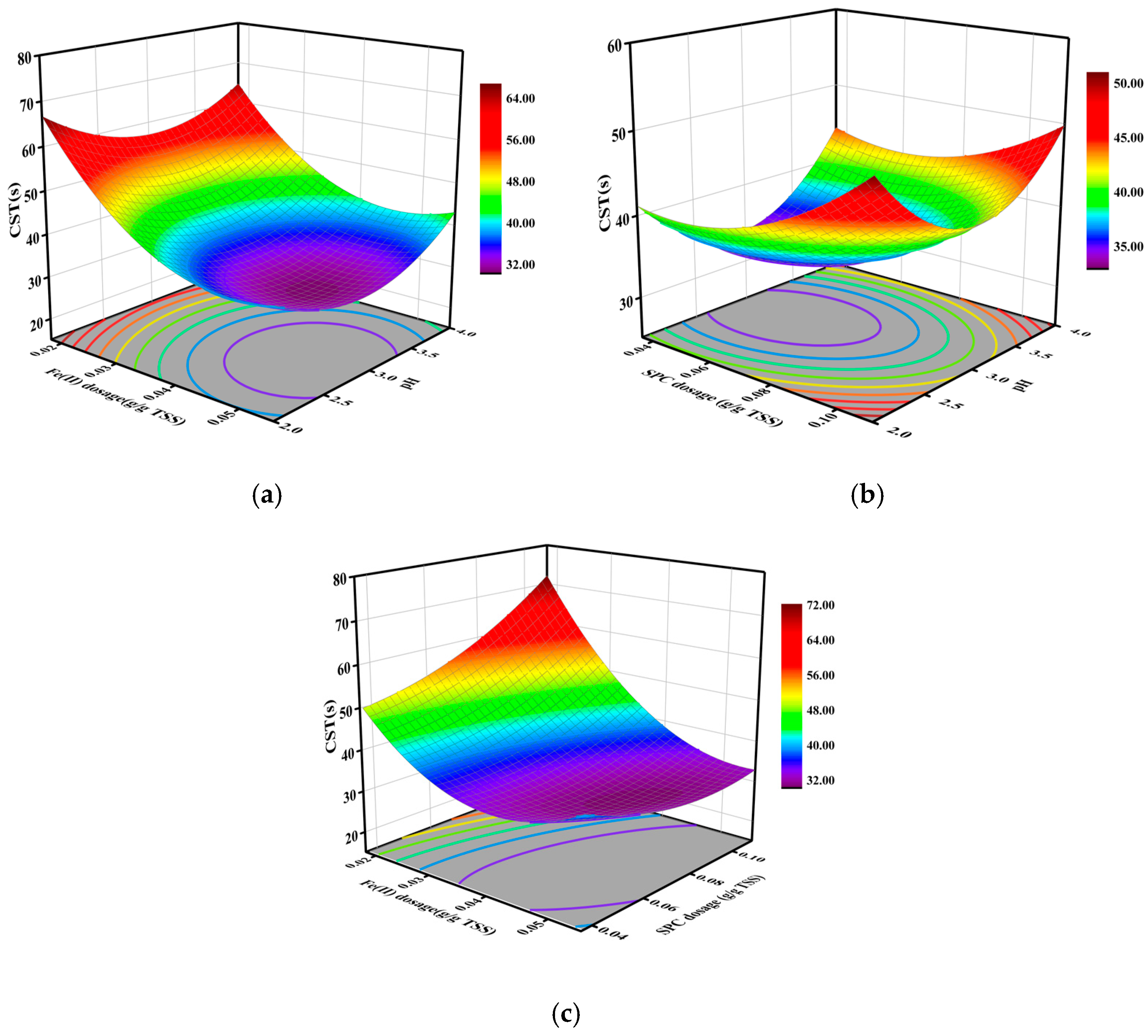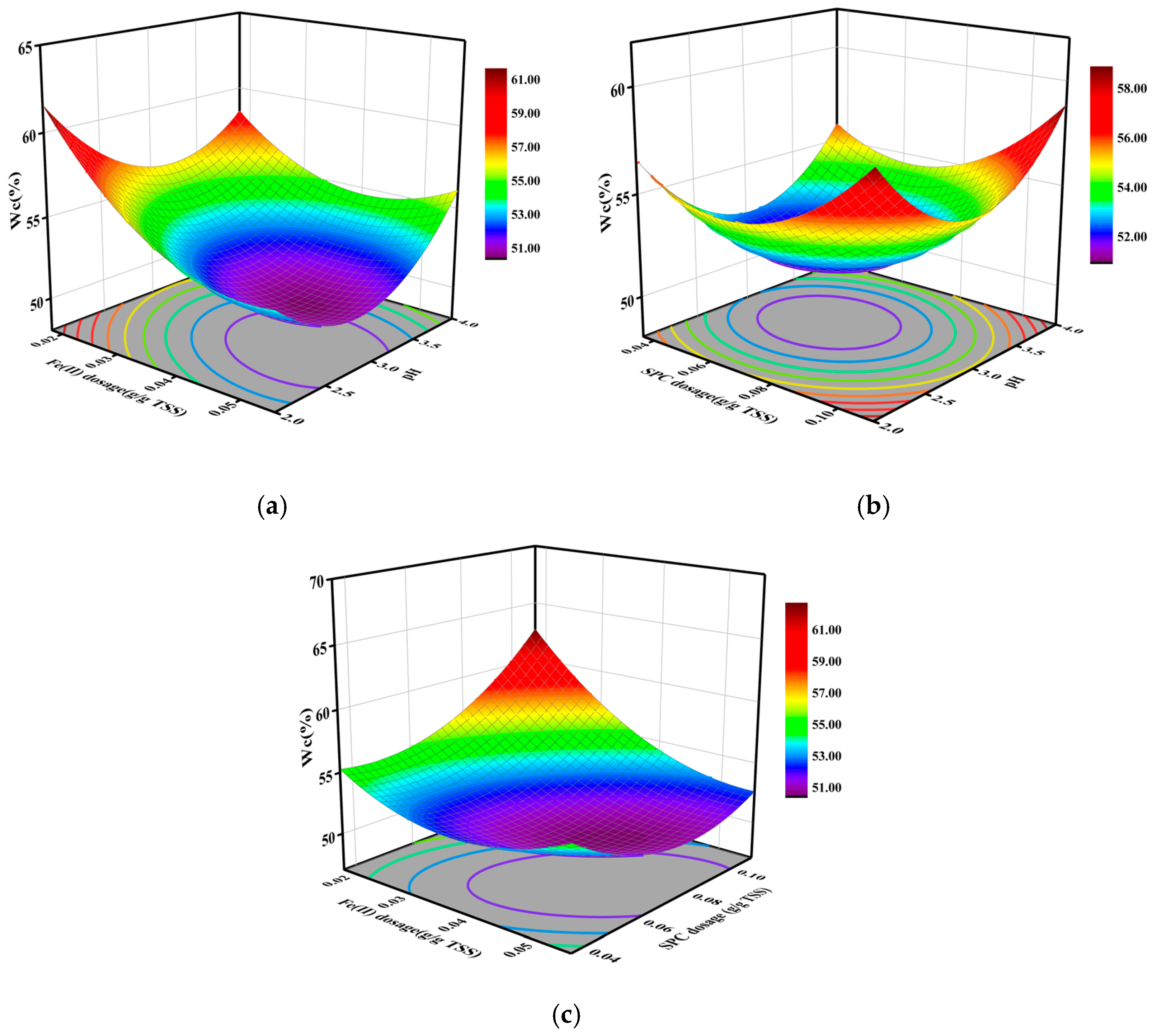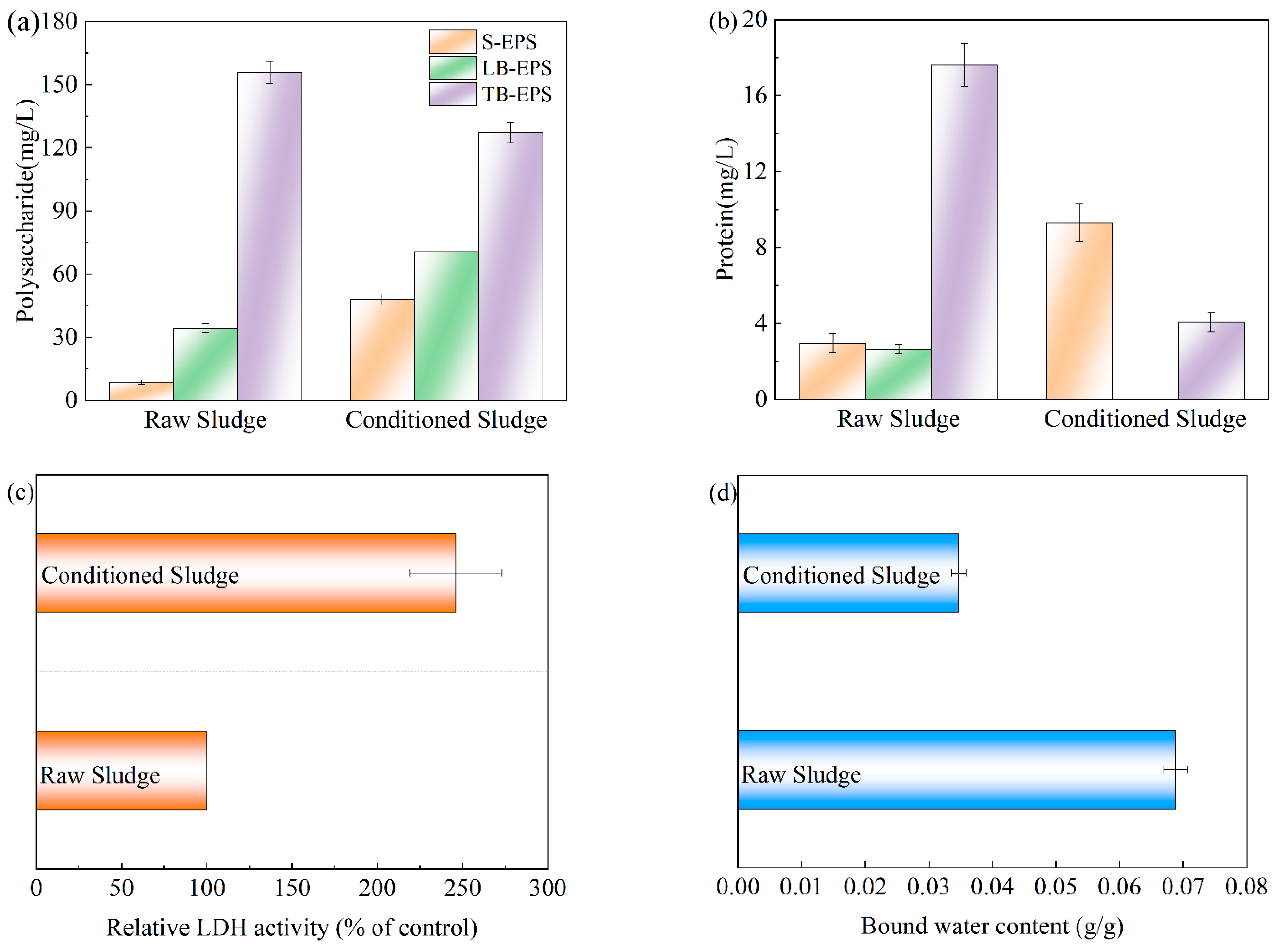Optimization of Fe(II)/SPC Sludge Conditioning and Dewatering Process Based on Response Surface Methodology: Full-Scale Application
Abstract
:1. Introduction
2. Materials and Methods
2.1. Materials and Reagents
2.2. Experimental Set-Up
2.2.1. Full-Scale Sludge Conditioning and Dewatering Process
2.2.2. Assessment of Sludge Dewaterability
2.2.3. EPS Extraction
2.2.4. Lactate Dehydrogenase Release Assay
2.2.5. Analytical Methods
2.3. RSM Model
3. Results and Discussion
3.1. Optimal Operation Condition for Fe(II)/SPC Sludge Conditioning by RSM Model
3.2. Effects of Fe(II)/SPC Process on Sludge Structure
3.3. Practical Implication
4. Conclusions
Supplementary Materials
Author Contributions
Funding
Data Availability Statement
Conflicts of Interest
References
- Qi, Y.; Thapa, K.B.; Hoadley, A.F.A. Benefit of lignite as a filter aid for dewatering of digested sewage sludge demonstrated in pilot scale trials. Chem. Eng. J. 2011, 166, 504–510. [Google Scholar] [CrossRef]
- Cao, B.; Zhang, T.; Zhang, W.; Wang, D. Enhanced technology based for sewage sludge deep dewatering: A critical review. Water Res. 2021, 189, 116650. [Google Scholar] [CrossRef] [PubMed]
- Wu, B.; Dai, X.; Chai, X. Critical review on dewatering of sewage sludge: Influential mechanism, conditioning technologies and implications to sludge re-utilizations. Water Res. 2020, 180, 116650. [Google Scholar] [CrossRef] [PubMed]
- Xing, Y.; Wang, Z.; Hong, C.; Yang, Q.; Feng, L.; Jia, M.; Li, Y. Mechanism and Parameter Optimization of Fenton’s Reagent Integrated with Surfactant Pretreatment to Improve Sludge Dewaterability. PLoS ONE 2017, 12, e0169523. [Google Scholar] [CrossRef]
- Liang, J.; Zhang, S.; Ye, M.; Huang, J.; Yang, X.; Li, S.; Huang, S.; Sun, S. Improving sewage sludge dewaterability with rapid and cost-effective in-situ generation of Fe2+ combined with oxidants. Chem. Eng. J. 2020, 380, 122499. [Google Scholar] [CrossRef]
- Ling, X.; Deng, J.; Ye, C.; Cai, A.; Ruan, S.; Chen, M.; Li, X. Fe(II)-activated sodium percarbonate for improving sludge dewaterability: Experimental and theoretical investigation combined with the evaluation of subsequent utilization. Sci. Total Environ. 2021, 799, 149382. [Google Scholar] [CrossRef]
- Sun, L.; Chen, C.; Zhou, S.; Yuan, W.; Lu, H.; Wang, H.; Zhu, X.; Deng, H.; Li, X.-Y.; Lin, L.; et al. Microbial iron reduction activating sodium percarbonate for improving the dewaterability of iron-rich sludge. Chem. Eng. J. 2023, 471, 144771. [Google Scholar] [CrossRef]
- Li, Y.; Zhu, Y.; Wang, D.; Yang, G.; Tang, W. Fe(II) catalyzing sodium percarbonate facilitates the dewaterability of waste activated sludge: Performance, mechanism, and implication. Water Res. 2020, 174, 115626. [Google Scholar] [CrossRef]
- Olivier, J.; Ginisty, P.; Vaxelaire, J. Sludge conditioning prior to dewatering: Introducing drainage index as a new parameter. Environ. Technol. Innov. 2018, 11, 286–298. [Google Scholar] [CrossRef]
- He, D.-Q.; Luo, H.-W.; Huang, B.-C.; Qian, C.; Yu, H.-Q. Enhanced dewatering of excess activated sludge through decomposing its extracellular polymeric substances by a Fe@Fe2O3-based composite conditioner. Bioresour. Technol. 2016, 218, 526–532. [Google Scholar] [CrossRef]
- Aydin, M.; Uslu, S.; Celik, M.B. Performance and emission prediction of a compression ignition engine fueled with biodiesel-diesel blends: A combined application of ANN and RSM based optimization. Fuel 2020, 269, 117472. [Google Scholar] [CrossRef]
- Cao, X.; Wang, F.; Yang, J. Using a combination of different conditioners to promote dewatering of digested sludge: Rheological characteristics. Environ. Res. 2023, 237, 116958. [Google Scholar] [CrossRef] [PubMed]
- Cai, M.-Q.; Hu, J.-Q.; Wells, G.; Seo, Y.; Spinney, R.; Ho, S.-H.; Dionysiou, D.D.; Su, J.; Xiao, R.; Wei, Z. Understanding Mechanisms of Synergy between Acidification and Ultrasound Treatments for Activated Sludge Dewatering: From Bench to Pilot-Scale Investigation. Environ. Sci. Technol. 2018, 52, 4313–4323. [Google Scholar] [CrossRef] [PubMed]
- Li, X.Y.; Yang, S.F. Influence of loosely bound extracellular polymeric substances (EPS) on the flocculation, sedimentation and dewaterability of activated sludge. Water Res. 2007, 41, 1022–1030. [Google Scholar] [CrossRef]
- Clesceri, L.S. Standard methods for examination of water and wastewater. Am. Public Health Assoc. 1998, 9, 387–388. [Google Scholar]
- Grintzalis, K.; Georgiou, C.D.; Schneider, Y.-J. An accurate and sensitive Coomassie Brilliant Blue G-250-based assay for protein determination. Anal. Biochem. 2015, 480, 28–30. [Google Scholar] [CrossRef]
- Shi, Y.; Yang, J.; Yu, W.; Zhang, S.; Liang, S.; Song, J.; Xu, Q.; Ye, N.; He, S.; Yang, C.; et al. Synergetic conditioning of sewage sludge via Fe2+/persulfate and skeleton builder: Effect on sludge characteristics and dewaterability. Chem. Eng. J. 2015, 270, 572–581. [Google Scholar] [CrossRef]
- Loewus, F.A. Improvement in Anthrone Method for Determination of Carbohydrates. Anal. Chem. 1952, 24, 219. [Google Scholar] [CrossRef]
- Latha, S.; Sivaranjani, G.; Dhanasekaran, D. Response surface methodology: A non-conventional statistical tool to maximize the throughput of Streptomyces species biomass and their bioactive metabolites. Crit. Rev. Microbiol. 2017, 43, 567–582. [Google Scholar] [CrossRef]
- Yaghoobian, S.; Zonoozi, M.H.; Saeedi, M. Performance evaluation of Fe-based water treatment sludge for dewatering of iron ore tailings slurry using coagulation-flocculation process: Optimization through response surface methodology. J. Environ. Manag. 2022, 316, 115240. [Google Scholar] [CrossRef]
- Liao, S.; Chen, J.; Huang, Z.; Yang, Z.; Xu, M.; Liao, T.; Zheng, J. Optimization for Extraction of Proanthocyanidins from Grape Seeds Using Response Surface Method. Chin. J. Trop. Crops 2011, 32, 554–559. [Google Scholar]
- Ding, N.; Peng, C.; Ren, Y.; Liu, Y.; Wang, P.; Dong, L.; Liu, H.; Wang, D. Improving the dewaterability of citric acid wastewater sludge by Fenton treatment. J. Clean. Prod. 2018, 196, 739–746. [Google Scholar] [CrossRef]
- Pignatello, J.J.; Oliveros, E.; MacKay, A. Advanced oxidation processes for organic contaminant destruction based on the Fenton reaction and related chemistry. Crit. Rev. Environ. Sci. Technol. 2006, 36, 1–48, Erratum in Crit. Rev. Environ. Sci. Technol. 2007, 37, 273–275. [Google Scholar] [CrossRef]
- Cui, H.; Gu, X.; Lu, S.; Fu, X.; Zhang, X.; Fu, G.Y.; Qiu, Z.; Sui, Q. Degradation of ethylbenzene in aqueous solution by sodium percarbonate activated with EDDS-Fe(III) complex. Chem. Eng. J. 2017, 309, 80–88. [Google Scholar] [CrossRef]
- Lyu, Y.; Lyu, S.; Tang, P.; Jiang, W.; Sun, Y.; Li, M.; Sui, Q. Degradation of trichloroethylene in aqueous solution by sodium percarbonate activated with Fe(II)-citric acid complex in the presence of surfactant Tween-80. Chemosphere 2020, 257, 127223. [Google Scholar] [CrossRef] [PubMed]
- Zhang, W.J.; Zhang, M.; Xiao, F.; Fang, L.P.; Wang, D.S. Pretreatment of high strength waste emulsions by combined vibratory shear enhanced process with Fenton oxidation. Int. J. Environ. Sci. Technol. 2014, 11, 731–738. [Google Scholar] [CrossRef]
- Zhang, W.; Yang, X.; Wang, D. Complete Removal of Organic Contaminants from Hypersaline Wastewater by the Integrated Process of Powdered Activated Carbon Adsorption and Thermal Fenton Oxidation. Ind. Eng. Chem. Res. 2013, 52, 5765–5771. [Google Scholar] [CrossRef]
- Li, Y.; Wang, D.; Yang, G.; Yuan, X.; Li, H.; Wang, Q.; Ni, B.; He, D.; Fu, Q.; Jiang, L.J.C.E.J. Comprehensive investigation into in-situ chemical oxidation of ferrous iron/sodium percarbonate (Fe(II)/SPC) processing dredged sediments for positive feedback of solid–liquid separation. Chem. Eng. J. 2021, 425, 130467. [Google Scholar] [CrossRef]
- Zhen, G.; Lu, X.; Wang, B.; Zhao, Y.; Chai, X.; Niu, D.; Zhao, A.; Li, Y.; Song, Y.; Cao, X. Synergetic pretreatment of waste activated sludge by Fe(II)-activated persulfate oxidation under mild temperature for enhanced dewaterability. Bioresour. Technol. 2012, 124, 29–36. [Google Scholar] [CrossRef]



| Factors | Range and Levels | ||
|---|---|---|---|
| −1 | 0 | 1 | |
| X1, Fe(II) dosage (g/g TSS) | 0.018 | 0.036 | 0.055 |
| X2, SPC dosage (g/g TSS) | 0.036 | 0.074 | 0.110 |
| X3, initial pH of sludge | 2 | 3 | 4 |
| Trial No. | Uncoded Variables (Codes) | ||
|---|---|---|---|
| X1 | X2 | X3 | |
| Fe(II) Dosage (g/g TSS) | SPC Dosage (g/g TSS) | Initial pH | |
| 1 | 0 | 0 | 0 |
| 2 | 0 | −1 | 1 |
| 3 | −1 | 0 | 1 |
| 4 | 1 | −1 | 0 |
| 5 | 1 | 1 | 0 |
| 6 | 0 | 0 | 0 |
| 7 | 1 | 0 | −1 |
| 8 | 0 | 1 | 1 |
| 9 | −1 | 0 | −1 |
| 10 | −1 | 1 | 0 |
| 11 | 0 | −1 | −1 |
| 12 | 0 | 0 | 0 |
| 13 | 0 | 0 | 0 |
| 14 | 0 | 0 | 0 |
| 15 | 0 | 1 | −1 |
| 16 | 1 | 0 | 1 |
| 17 | −1 | −1 | 0 |
| (Response 1: CST) Source | Sum of Squares | df | Mean Square | F-Value | p-Value |
|---|---|---|---|---|---|
| Model | 2505.65 | 9 | 278.41 | 15.57 | 0.0008 |
| X1-Fe(II) dosage | 1207.86 | 1 | 1207.86 | 67.54 | <0.0001 |
| X2-SPC dosage | 118.58 | 1 | 118.58 | 6.63 | 0.0367 |
| X3-pH | 1.71 | 1 | 1.71 | 0.0957 | 0.7661 |
| X1 X2 | 213.16 | 1 | 213.16 | 11.92 | 0.0107 |
| X1 X3 | 9.3 | 1 | 9.3 | 0.5201 | 0.4942 |
| X2 X3 | 4.41 | 1 | 4.41 | 0.2466 | 0.6347 |
| X12 | 486.35 | 1 | 486.35 | 27.19 | 0.0012 |
| X22 | 64.78 | 1 | 64.78 | 3.62 | 0.0987 |
| X32 | 314.86 | 1 | 314.86 | 17.61 | 0.0041 |
| Residual | 125.19 | 7 | 17.88 | ||
| Lack of Fit | 117.54 | 3 | 39.18 | 20.49 | 0.0069 |
| Pure Error | 7.65 | 4 | 1.91 | ||
| Cor Total | 2630.84 | 16 |
| (Response 2: Wc) Source | Sum of Squares | df | Mean Square | F-Value | p-Value |
|---|---|---|---|---|---|
| Model | 228.92 | 9 | 25.44 | 10.44 | 0.0027 |
| X1-Fe(II) dosage | 54.08 | 1 | 54.08 | 22.19 | 0.0022 |
| X2-SPC dosage | 13 | 1 | 13 | 5.34 | 0.0542 |
| X3-pH | 0.18 | 1 | 0.18 | 0.0739 | 0.7936 |
| X1 X2 | 23.52 | 1 | 23.52 | 9.65 | 0.0172 |
| X1 X3 | 8.12 | 1 | 8.12 | 3.33 | 0.1106 |
| X2 X3 | 0.2025 | 1 | 0.2025 | 0.0831 | 0.7815 |
| X12 | 27.97 | 1 | 27.97 | 11.48 | 0.0116 |
| X22 | 30.19 | 1 | 30.19 | 12.39 | 0.0097 |
| X32 | 58.5 | 1 | 58.5 | 24.01 | 0.0018 |
| Residual | 17.06 | 7 | 2.44 | ||
| Lack of Fit | 12.13 | 3 | 4.04 | 3.28 | 0.1405 |
| Pure Error | 4.93 | 4 | 1.23 | ||
| Cor Total | 245.98 | 16 |
| Variable | Goal | Upper Limit | Lower Limit | Importance |
|---|---|---|---|---|
| Fe(II) dosage (g/g TSS) | In range | 0.055 | 0.018 | 3 |
| SPC dosage (g/g TSS) | In range | 0.110 | 0.036 | 3 |
| Initial pH | In range | 4 | 2 | 3 |
| Sludge CST (s) | Minimum | - | - | 5 |
| Dewatered sludge Wc (%) | Minimum | - | - | 5 |
| Fe(II) Dosage (g/g TSS) | SPC Dosage (g/g TSS) | Initial pH | Sludge CST (s) | Dewatered Sludge Wc (%) | ||
|---|---|---|---|---|---|---|
| Actual | Predicted | Actual | Predicted | |||
| 0.05 | 0.07 | 3.02 | 31.6 | 30.47 | 51.47 | 50.46 |
| 34.1 | 52.37 | |||||
| 33.5 | 51.66 | |||||
| Process | Chemicals | Dosage (t/t TSS) | Unit Price 1 (USD$/t) | Cost (USD$/t TSS) | Total Cost (USD$/t TSS) | Wc (%) |
|---|---|---|---|---|---|---|
| PFS | Polyferric sulfate | 0.03 | 1600 | 48 | 48 | >62 |
| Fenton | FeSO4·7H2O | 0.26 | 70 | 18.2 | 73.65 | 48–52 |
| H2O2 (27.5%) | 0.164 | 300 | 49.2 | |||
| H2SO4 (98%) | 0.05 | 125 | 6.25 | |||
| Fe(II)/SPC | FeSO4·7H2O | 0.233 | 70 | 16.31 | 61.76 | 51.8 |
| NaCO3·1.5H2O2 | 0.07 | 560 | 39.2 | |||
| H2SO4 (98%) | 0.05 | 125 | 6.25 |
Disclaimer/Publisher’s Note: The statements, opinions and data contained in all publications are solely those of the individual author(s) and contributor(s) and not of MDPI and/or the editor(s). MDPI and/or the editor(s) disclaim responsibility for any injury to people or property resulting from any ideas, methods, instructions or products referred to in the content. |
© 2023 by the authors. Licensee MDPI, Basel, Switzerland. This article is an open access article distributed under the terms and conditions of the Creative Commons Attribution (CC BY) license (https://creativecommons.org/licenses/by/4.0/).
Share and Cite
Zhou, S.; Chen, C.; Li, R. Optimization of Fe(II)/SPC Sludge Conditioning and Dewatering Process Based on Response Surface Methodology: Full-Scale Application. Water 2023, 15, 3838. https://doi.org/10.3390/w15213838
Zhou S, Chen C, Li R. Optimization of Fe(II)/SPC Sludge Conditioning and Dewatering Process Based on Response Surface Methodology: Full-Scale Application. Water. 2023; 15(21):3838. https://doi.org/10.3390/w15213838
Chicago/Turabian StyleZhou, Siru, Chuanhan Chen, and Ruohong Li. 2023. "Optimization of Fe(II)/SPC Sludge Conditioning and Dewatering Process Based on Response Surface Methodology: Full-Scale Application" Water 15, no. 21: 3838. https://doi.org/10.3390/w15213838






